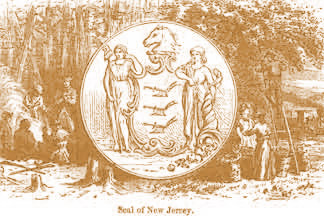New Jersey Colony

Seal
The colony of New Jersey was initially part of the New Netherlands colony. However, the Dutch were slow to settle the colony. Initially they settled some of the land that surrounded New York Harbor. Colonists from New Sweden settled in Southern New Jersey. In 1664, the British conquered New Netherlands. King Charles II gave the whole area between New England and Maryland to his brother the Duke of York. The Duke of New York then granted the land between the Hudson and Delaware Rivers to the Sir George Carteret and Lord Berkeley. Both had been loyal to him during the English Civil War. They named the colony New Jersey after the English Channel Island of Jersey.
The new proprietors did all they could to increase settlement in the colony. They guaranteed the religious freedom to those who were willing to settle in New Jersey. Philip Carteret was appointed the first governor of the New Jersey colony. Carteret established his the first capital at Elizabethtown. It was difficult for the proprietors to collect any taxes from the inhabitant. So, in March 1673 Berkeley sold his part of the colony to the Quakers. After the sale to the Quakers the colony was divided into two East and West Jersey. That political division lasted between 1674 and 1702.
New Jersey was home to many religious denominations with the Dutch Reformed Church being one of the largest. The first College in the colony was Queens College, (now called “Rutgers”) was founded in 1766.
In 1702 the proprietors of the colony turned it back to the crown. It was ruled thereafter as a royal colony. For many years New Jersey was part of New York colony. In 1738, as a result of the efforts of Lewis Morris, New Jersey gained its independence from New York. The last Royal governor of New Jersey was William Franklin, the son of Benjamin Franklin. The Continental Congress deposed him in 1776. The younger Franklin fled to Connecticut and then to England.
.
 >
>